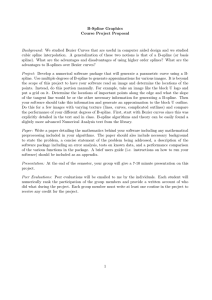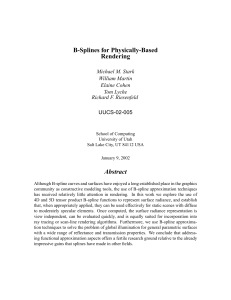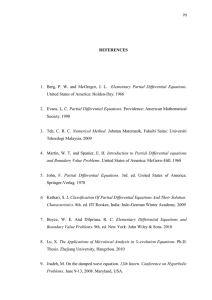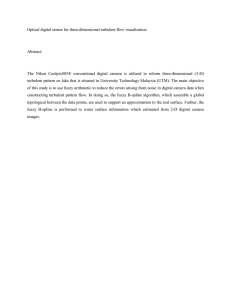n - Journal of Computers
advertisement
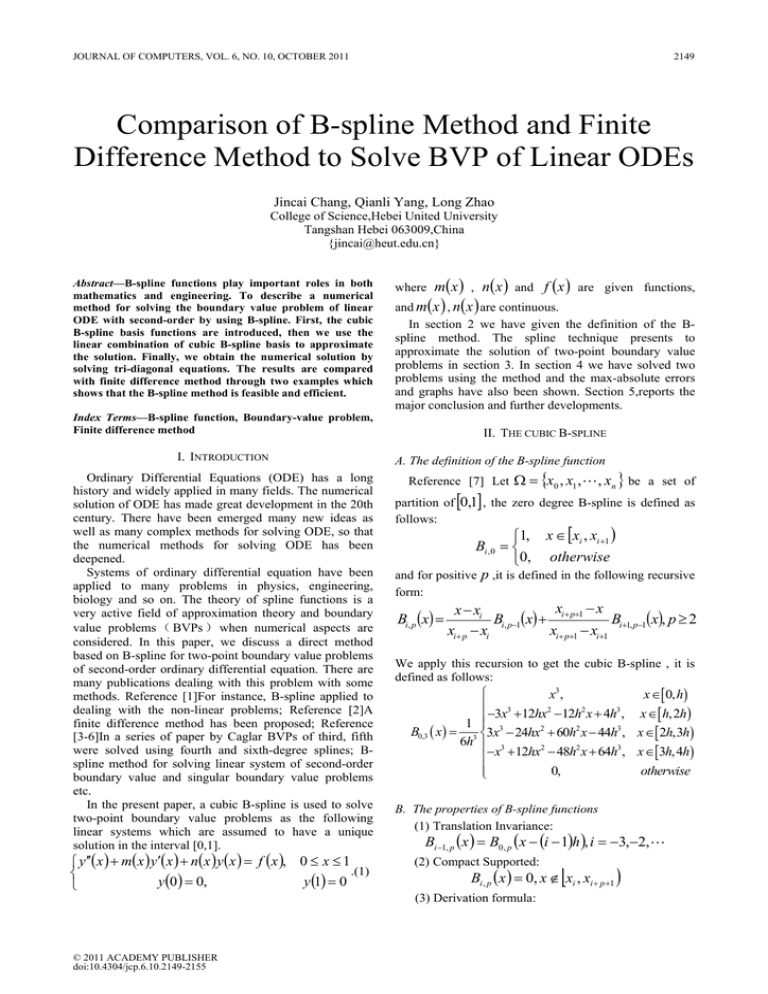
JOURNAL OF COMPUTERS, VOL. 6, NO. 10, OCTOBER 2011
2149
Comparison of B-spline Method and Finite
Difference Method to Solve BVP of Linear ODEs
Jincai Chang, Qianli Yang, Long Zhao
College of Science,Hebei United University
Tangshan Hebei 063009,China
{jincai@heut.edu.cn}
Abstract—B-spline functions play important roles in both
mathematics and engineering. To describe a numerical
method for solving the boundary value problem of linear
ODE with second-order by using B-spline. First, the cubic
B-spline basis functions are introduced, then we use the
linear combination of cubic B-spline basis to approximate
the solution. Finally, we obtain the numerical solution by
solving tri-diagonal equations. The results are compared
with finite difference method through two examples which
shows that the B-spline method is feasible and efficient.
where m( x ) , n( x ) and f ( x ) are given functions,
and m( x ) , n( x ) are continuous.
In section 2 we have given the definition of the Bspline method. The spline technique presents to
approximate the solution of two-point boundary value
problems in section 3. In section 4 we have solved two
problems using the method and the max-absolute errors
and graphs have also been shown. Section 5,reports the
major conclusion and further developments.
Index Terms—B-spline function, Boundary-value problem,
Finite difference method
I. INTRODUCTION
Ordinary Differential Equations (ODE) has a long
history and widely applied in many fields. The numerical
solution of ODE has made great development in the 20th
century. There have been emerged many new ideas as
well as many complex methods for solving ODE, so that
the numerical methods for solving ODE has been
deepened.
Systems of ordinary differential equation have been
applied to many problems in physics, engineering,
biology and so on. The theory of spline functions is a
very active field of approximation theory and boundary
value problems ( BVPs ) when numerical aspects are
considered. In this paper, we discuss a direct method
based on B-spline for two-point boundary value problems
of second-order ordinary differential equation. There are
many publications dealing with this problem with some
methods. Reference [1]For instance, B-spline applied to
dealing with the non-linear problems; Reference [2]A
finite difference method has been proposed; Reference
[3-6]In a series of paper by Caglar BVPs of third, fifth
were solved using fourth and sixth-degree splines; Bspline method for solving linear system of second-order
boundary value and singular boundary value problems
etc.
In the present paper, a cubic B-spline is used to solve
two-point boundary value problems as the following
linear systems which are assumed to have a unique
solution in the interval [0,1].
⎧ y′′( x ) + m( x ) y′( x ) + n( x ) y ( x ) = f ( x ), 0 ≤ x ≤ 1
.(1)
⎨
y (0 ) = 0,
y (1) = 0
⎩
II. THE CUBIC B-SPLINE
A. The definition of the B-spline function
Reference [7] Let Ω = {x0 , x1 ," , xn } be a set of
[ ]
partition of 0,1 , the zero degree B-spline is defined as
follows:
⎧1, x ∈ [xi , xi +1 )
Bi ,0 = ⎨
⎩0, otherwise
and for positive p ,it is defined in the following recursive
form:
Bi, p (x) =
xi+ p+1 − x
x − xi
Bi+1, p−1(x), p ≥ 2
Bi, p−1(x) +
xi+ p+1 − xi+1
xi+ p − xi
We apply this recursion to get the cubic B-spline , it is
defined as follows:
⎧
x ∈[ 0, h)
x3 ,
⎪ 3
2
2
3
−3x +12hx −12h x + 4h , x ∈[ h,2h)
1 ⎪⎪
B0,3 ( x ) = 3 ⎨3x3 − 24hx2 + 60h2 x − 44h3 , x ∈[ 2h,3h)
6h ⎪ 3
−x +12hx2 − 48h2 x + 64h3 , x ∈[3h,4h)
⎪
0,
otherwise
⎩⎪
B. The properties of B-spline functions
(1) Translation Invariance:
Bi −1, p (x ) = B0, p ( x − (i − 1)h ), i = −3,−2,"
(2) Compact Supported:
(3) Derivation formula:
© 2011 ACADEMY PUBLISHER
doi:10.4304/jcp.6.10.2149-2155
[
Bi , p ( x ) = 0, x ∉ xi , xi + p +1 )
2150
JOURNAL OF COMPUTERS, VOL. 6, NO. 10, OCTOBER 2011
Bi(,kp) (x ) =
Where
⎧α 0,0
⎪
⎪α k ,0
⎪
⎪⎪
⎨α
⎪ k ,k
⎪
⎪
⎪α k , j
⎪⎩
and A is an (n + 3) × (n + 3) -dimensional tri-diagonal
matrix given by
p! k
α k , j Bi + j , p − k
( p − k )! ∑
j =0
4
1
0
⎡ 1
⎢a (x ) b (x ) c (x ) 0
⎢0 0 0 0 0 0
⎢ 0
a1(x1 ) b1(x1 ) c1(x1)
A= ⎢
#
#
#
⎢ #
⎢ 0
0
0
0
⎢
0
0
0
⎣⎢ 0
=1
α k −1,0
=
xi + p − k +1 − xi
−α k −1, k −1
=
xi + p + j − k +1 − xi + j
PROBLEMS
Let
n −1
y ( x ) ∑ c j B j ,3 ( x ) .
(2)
j = −3
be an approximate solution of Eq.(1),where ci is
unknown real coefficient and B j ,3 ( x ) are cubic B-spline
functions. Let x0 , x1 ," , xn are n + 1 grid points in the
[ ]
interval a, b ,so that xi = a + ih , i = 0,1," , n ,
x0 = a, xn = b , h = (b − a ) n .It is required that the
approximate solution(2)satisfies the differential equation
at the points x = xi . Putting (3) in (1),it follow that
∑c [B′′ (x ) +m(x )B′ (x ) + n(x )B (x )] .
n−1
j
j,3
i
i
j,3
i
i
j,3
i
(3)
= f (xi ),i = 0,1,", n
and boundary condition can be written as
∑ c B (0) = 0, for x = 0 .
j = −3
(4)
j ,3
n −1
∑ c B (1) = 0, for x = 1 .
j = −3
j
(5)
j ,3
The spline solution of (1) is
following matrix equation.
n + 3 linear equations in
c−3 , c− 2 ," , cn −1 are obtained,
obtained by solving the
Then, a systems of
the n + 3 unknowns
using(2)can obtain the
numerical solution. This systems can be written in the
matrix-vector form as follows:
AB = F .
(6)
Where
B = [c−3 , c− 2 ," , cn −1 ] ,
T
F = [0, f ( x0 ), f ( x1 )," , f (xn ),0]
T
© 2011 ACADEMY PUBLISHER
0 "
0
0
0 "
0
0
# #
#
#
0 " an (xn ) bn (xn )
0 "
1
4
0 ⎤
0 ⎥⎥
. (7)
0 ⎥
⎥
# ⎥
cn (xn )⎥
⎥
1 ⎦⎥
−3
6
+ m ( xi ) + n ( xi ) , ( i = 0,1, " , n )
2
h
h
−12
bi ( xi ) = 2 + 4n ( xi ) , ( i = 0,1, ", n )
h
6
3
ci ( xi ) = 2 + m ( xi ) + n ( xi ) , ( i = 0,1, " , n )
h
h
Then , a system of linear equations can be build as shown
below:
4
1
0
⎡ 1
⎢a (x ) b (x ) c (x ) 0
⎢0 0 0 0 0 0
⎢ 0
a1(x1) b1(x1) c1(x1)
⎢
#
#
#
#
⎢
⎢ 0
0
0
0
⎢
0
0
0
⎢⎣ 0
⎡ 0 ⎤
⎢ f (x )⎥
0 ⎥
⎢
⎢ # ⎥
= 6⎢
⎥
⎢ # ⎥
⎢ f ( xn )⎥
⎢
⎥
⎣⎢ 0 ⎦⎥
0 "
0
0
0 "
0 "
0
0
0
0
# #
#
#
0 " an (xn ) bn (xn )
0 "
1
4
0 ⎤
0 ⎥⎥
0 ⎥
⎥
# ⎥
cn (xn )⎥
⎥
1 ⎥⎦
⎡ c−3 ⎤
⎢c ⎥
⎢ −2 ⎥
⎢ # ⎥
⎢ ⎥
⎢ # ⎥
⎢cn−2 ⎥
⎢ ⎥
⎢⎣cn−1 ⎥⎦
IV. NUMERICAL RESULTS
n −1
j
0
ai ( xi ) =
α k − j , j − α k −1, j −1
Ⅲ. B-SPLINE SOLUTIONS FOR LINEAR BOUNDARY VALUE
j=−3
0
also the coefficients in the matrix A have the following
form
xi + p +1 − xi + k
=
0 "
Reference [8]In this section, two numerical examples
are studied by B-spline, finite difference method. The
results obtained by the method are compared with the
analytical solution, so that we get the maximum absolute
errors, then demonstrate the accuracy of the B-spline
method. We can find that our method in comparison with
the method of finite difference is much better with a view
to accuracy and utilization. Moreover, the maximum
absolute errors are given in Table1 and 2.The numerical
results are illustrated in Fig.1, 2, 3 and Fig.4.
Example 1: Solve the following boundary value
problem
⎧ y′′( x ) − y′( x ) = −e x −1 − 1, 0 ≤ x ≤ 1
.
⎨
y (0 ) = 0,
y (1) = 0
⎩
The analytical solution:
y ( x ) = x(1 − e x −1 )
(8)
JOURNAL OF COMPUTERS, VOL. 6, NO. 10, OCTOBER 2011
2151
Respectively, the observed maximum absolute errors
for various value of n are given in Table 1.The numerical
results are illustrated in Fig.1 and 2.
Method 1: we can get the coefficient matrix A by
using(7) for n = 10
4
1
0
⎡ 1
⎢(6+3h) h2 −12h2 (6−3h) h2
0
⎢
⎢ 0
(6+3h) h2 −12h2 (6−3h) h2
A=⎢
#
#
#
⎢ #
⎢ 0
0
0
0
⎢
0
0
0
⎣⎢ 0
0 "
0
0
#
0
0
"
"
#
"
"
y1 =0.0593827,
y2 =0.110234,
y3 = 0.1512
y4 =0.1806167,
⎤
0
0
0 ⎥⎥
0
0
0 ⎥
⎥
#
#
# ⎥
2
2
2⎥
(6+3h) h −12h (6−3h) h
⎥
1
4
1 ⎦⎥
0
0
0
y5 =0.1969833,
y6 =0.198083334
y7 = 0.18165523,
y8 = 0.1452,
And
y9 = 0.08571
F = [0,−8.2073,−8.4394,",−11.4290,−12.0000,0]
T
the analytical solutions are given by
Then, if h = 0.1 , we can find B as follows:
y1 ( x1 ) =0.0593,
B = [− 0.0657,0.0012,0.0608," ,0.0050,−0.1102]
T
y2 ( x2 ) =0.1101,
And we can get the function
y(x ) =
y3 ( x3 ) = 0.1510,
n −1
∑ c B (x )
j = −3
j
y4 ( x4 ) = 0.1805,
j ,3
y5 ( x5 ) =0.1967,
for example
y0 ( x) = −0.2x 3 − 0.365x 2 + 0.6325x − 0.0000166667
x ∈ [0,0.1) ;
y6 ( x6 ) =0.1978,
y1 (x) = −0.233x3 − 0.355x 2 + 0.6315x + 0.000016
x ∈[0.1,0.2) ;
3
y2 (x) = −0.25x − 0.3449x 2 + 0.6294x + 0.00015,
and
x ∈[0.2,0.3) ;
y3 (x) = −0.3x 3 − 0.3x 2 + 0.616x + 0.0015,
x ∈[0.3,0.4) ;
y4 (x) = −0.32x3 − 0.28x2 + 0.608x + 0.002483,
x ∈[0.4,0.5) ;
y5 (x ) = −0.4 x − 0.155x + 0.5455x + 0.0129833 ,
3
2
x∈[0.5,0.6) ;
y6 (x) = −0.417x − 0.125x + 0.5275x + 0.0165833,
3
2
x∈[0.6,0.7) ;
y7 (x ) = −0.467x − 0.02x 2 + 0.454x + 0.033733 ,
3
x∈[0.7,0.8) ;
y8 (x) = −0.6x3 + 0.3x2 + 0.198x + 0.102,
x ∈[0.8,0.9) ;
y9 (x) = −0.6x3 + 0.3x2 + 0.1979x + 0.102,
x ∈[0.9,1) ;
Therefore, numerical solutions are obtained by the Bspline method, they follow that
y7 ( x7 ) =0.1814,
y8 ( x8 ) =0.1450,
y9 ( x9 ) =0.0856,
y1 ( x1 ) − y1 = − 0.0000827,
y 2 ( x2 ) − y 2 = − 0.000134,
y3 ( x3 ) − y3 = − 0.0002,
y 4 ( x4 ) − y 4 =0.000117,
y5 ( x5 ) − y5 = − 0.0002833,
y 6 ( x6 ) − y 6 =0.00023334
y 7 ( x7 ) − y 7 = − 0.00025523,
y8 ( x8 ) − y8 = − 0.0002,
y9 ( x9 ) − y9 = − 0.00011,
Thus, the max-absolute error is given by
δ = 0.00025523
Reference [9]Method 2 Finite difference method: At
first, the interval of solution is divided into many small
regions and get the set of internal node. In these nodes,
we use difference coefficient instead of differential. We
reject the truncation error and establish the differential
equations. Then, we can obtain the numerical solution by
combining the boundary conditions.
Consider the linear boundary value problem
y′′ = q1 ( x ) y′ + q2 ( x ) y + q3 ( x ), x ∈ a, b .
(9)
[ ]
© 2011 ACADEMY PUBLISHER
2152
JOURNAL OF COMPUTERS, VOL. 6, NO. 10, OCTOBER 2011
y (a ) = α , y (b ) = β .
[ ]
⎡ y ( x1 ) ⎤
⎢ y(x ) ⎥
2 ⎥
⎢
Y =⎢ # ⎥
⎥
⎢
⎢ y ( xn − 2 )⎥
⎢⎣ y ( xn −1 )⎥⎦
⎡ q (x ) ⎤
h 2 q3 ( x1 ) − ⎢1 + 1 1 h ⎥α
2
⎦
⎣
2
h q3 ( x2 )
(10)
Collocation points are knot averages in interval a, b ,let
xk = a + kh(k = 0,1,2," , n ) , are grid points in the
interval [a, b ] ,so that x0 = a, xn = b ,we use first-order
and second-order centered difference instead of the first
and second derivative at the internal knots, and
yk substitute into y ( xk )
y ( xk +1 ) − y (xk −1 )
+ Ο h2
2h
y ( xk +1 ) − 2 y (xk ) + y ( xk −1 )
y′′( xk ) =
+ Ο h2
h2
( )
y′( xk ) =
( )
Then, we get a differential equation which truncation
error is Ο
(h ) ,it follows that
2
1
[ yk −1 − 2 yk + yk +1 ] + q1 (xk ) [ yk −1 − yk +1 ]
2
2h
h
− q2 ( xk ) yk = q3 (xk )
⎡
⎤
⎢
⎥
⎢
⎥
⎢
⎥
⎥
B=⎢
#
⎢
⎥
h 2 q3 (xn − 2 )
⎢
⎥
⎢ 2
⎡ q (x ) ⎤ ⎥
⎢h q3 ( xn −1 ) − ⎢1 − 1 n −1 h ⎥ β ⎥
2
⎦ ⎦
⎣
⎣
From (8) and (9) we have
q1 ( x ) = 1, q2 (x ) = 0, q3 ( x ) = −e x −1 − 1 .
Hence, numerical solutions are obtained by the Finite
difference method, they follow that
Also, combined with the boundary value problem
y1 =0.0595,
y (a ) = α , y (b ) = β
y2 =0.1103,
And, the linear equations as follow
⎧
⎡ q1 ( x1 ) ⎤
2
(
)
−
+
+
h
q
x
y
2
2
1
1
⎪
⎢1− 2 h⎥ y2
⎣
⎦
⎪
⎡ q (x )h ⎤
⎪
= h2q3 (x1 ) − ⎢1+ 1 1 ⎥α
⎪
2 ⎦
⎣
⎪
⎡ q1 (xk ) ⎤
⎪
h⎥ yk −1 − 2 + h2q2 (xk ) yk +
1+
⎢
⎪
2 ⎦
⎣
⎨
⎪⎡1− q1 (xk ) h⎤ yk +1 = h2q3 (xk )(k = 2,3,", n − 2)
2 ⎥⎦
⎪⎢⎣
⎪ ⎡ q1 (xn−1 ) ⎤
h⎥ yn−2 − 2 + h2q2 (xk ) yn−1
⎪ ⎢1+
2
⎦
⎪ ⎣
⎪
⎡ q1 (xn−1 )h ⎤
2
(
)
=
−
h
q
x
3
n
−
1
⎪
⎢1 −
⎥β
2
⎣
⎦
⎩
[
]
[
]
Where
(
)
1−
(
q1(x1 )
h
2
)
− 2 + h2q2 (x2 )
%
%
q (x )
1+ 1 n−2 h
2
© 2011 ACADEMY PUBLISHER
y4 =0.1808,
y5 =0.1971,
y6 =0.1981,
1−
(
q1(x2 )
h
2
%
%
)
− 2 + h2q2 (xn−2 )
1+
y7 =0.1817,
y8 =0.1452,
y9 =0.0857,
also the max-absolute error is given by
δ = 0.0004
Example 2: we solve the following equations ,where
⎧ y′′( x ) − 2 y′( x ) − 2 y ( x ) = −2, 0 ≤ x ≤ 1
⎨
y (0) = 0,
y (1) = 0
⎩
Which has the exact solution is
(e
y( x) =
1− 3
AY = B ,
⎡
2
⎢− 2 + h q2 (x1 )
⎢
q (x )
⎢ 1+ 1 2 h
2
⎢
⎢
A= ⎢
⎢
⎢
⎢
⎢
⎢⎣
y3 = 0.1513
]
[
That is,
q1( xn−1 )
h
2
(11)
⎤
⎥
⎥
⎥
⎥
⎥
⎥
⎥
q1( xn−2 ) ⎥
1−
h
⎥
2
⎥
− 2 + h2q2 (xn−1 ) ⎥
⎦
(
)
)
(1+ 3) x
−1 e
e1+ 3 −e1− 3
(+ 1−e ) e(
1+ 3
)
1− 3 x
e1+ 3 −e1− 3
+1
Respectively, the observed maximum absolute errors for
various value of n are given in Table 2.The numerical
results are illustrated in Fig.3 and 4.As is evident from
the numerical results, the present method approximates
the exact solution very well.
Method 1: we can get the coefficient matrix A by using(7)
for n = 10
JOURNAL OF COMPUTERS, VOL. 6, NO. 10, OCTOBER 2011
4
1
0
⎡ 1
⎢6 h2 +6h−2 −12h2 −8 6 h2 −6h−2
0
⎢
⎢ 0
6 h2 +6h−2 −12h2 −8 6 h2 −6h−2
A=⎢
#
#
#
⎢ #
⎢ 0
0
0
0
⎢
0
0
0
⎣⎢ 0
2153
⎤
⎥
⎥
0"
0
0
0 ⎥
⎥
# #
#
#
# ⎥
2
2
2
0 " 6 h +6h−2 −12h −8 6 h −6h−2⎥
⎥
0"
1
4
1 ⎦⎥
0"
0
0
0
0"
0
0
0
y1 =0.05657,
y2 =0.1042973333,
y3 = 0.1464166667
y4 =0.1763666667,
y5 =0.1939916667,
And
F = [0,−12,−12," ,−12,−12,0]
Then, if h = 0.1 , we can find B as follows:
T
B = [− 0.0638,0.0013," ,0.0071,−0.1273]
y6 =0.1982966667
T
And we can get the function y ( x ) =
y7 = 0.18655,
y8 = 0.1537706667,
n −1
∑ c B (x ) ,for
j = −3
j
j ,3
y9 = 0.0909366667,
the analytical solutions are given by
y1 ( x1 ) =0.0572,
example
y 0 ( x ) = −0.1x 3 − 0.385 x 2 + 0.6125 x + 0.0000166667
y2 ( x2 ) =0.1061,
x ∈[0,0.1) ;
y3 ( x3 ) = 0.1460
y1 (x ) = −0.083x3 − 0.39x 2 + 0.613x ,
y4 ( x4 ) = 0.1758,
x ∈[0.1,0.2) ;
y2 (x) = −0.217x3 − 0.31x2 + 0.597x − 0.0010666667
x ∈[0.2,0.3) ;
y5 ( x5 ) =0.1940,
y6 ( x6 ) =0.1983
y3 ( x) = −0.25x3 + 29.255x 2 − 8.2725x + 0.0020 ,
y7 ( x7 ) =0.1858,
y4 ( x ) = −0.35x 3 − 0.16x 2 + 0.54x + 0.0084 ,
y9 ( x9 ) =0.0928
x ∈[0.3,0.4) ;
x ∈[0.4,0.5) ;
y5 (x) = −0.5x + 0.065x2 + 0.4275x + 0.027,
3
x ∈[0.5,0.6) ;
y6 (x) = −0.67x3 + 0.365x2 + 0.2475x + 0.063,
x∈[0.6,0.7) ;
y7 (x) = −0.9x + 0.855x − 0.0955x + 0.14315,
3
2
x∈[0.7,0.8) ;
y8 (x) = −1.183x +1.535x − 0.6395x + 0.289,
3
2
x ∈[0.8,0.9) ;
y9 (x) = −1.57x3 + 2.57x2 −1.571x + 0.568,
x∈[0.9,1) ;
Therefore, numerical solutions are obtained by the Bspline method, they follow that
© 2011 ACADEMY PUBLISHER
y8 ( x8 ) =0.1524,
and
y1 ( x1 ) − y1 =0.00063,
y2 ( x2 ) − y2 =0.0018,
y3 ( x3 ) − y3 = − 0.00042,
y4 ( x4 ) − y4 = − 0.00057,
y5 ( x5 ) − y5 = − 0.0000083,
y6 ( x6 ) − y6 =0.0000033,
y7 ( x7 ) − y7 = − 0.00075,
y8 ( x8 ) − y8 = − 0.0014,
y9 ( x9 ) − y9 =0.001863,
Thus, the max-absolute error is given by
δ = 0.001863
Method 2: The numerical solutions are obtained by the
Finite difference method, they follow that
2154
JOURNAL OF COMPUTERS, VOL. 6, NO. 10, OCTOBER 2011
y1 =0.0399,
y2 =0.0897,
y3 = 0.1302,
y4 =0.1604,
y5 =0.1787,
y6 =0.1827,
y7 =0.1695,
problems of differential equations. Several references
given in this paper are of great practical importance but
space constraints did not allow their discussion here.
Finally, it can be observed from this article that a
significant amount of work has been done and there is a
large scope of work to be done in this field.
Reference [12-21]The above two examples are the
deformation of singular perturbation problem. The
singularly-perturbed differential equation is that
− εy′′( x ) + m( x ) y′( x ) + n( x ) y ( x ) = f ( x )
y8 =0.1350,
y9 =0.0735,
also the max-absolute error is given by
δ = 0.0193
From the results, we will see the difference between
them and conclude that the B-spline method is the better
to interpolate any smooth functions than others. The
numerical results for our example are shown in Table 1
and 2,which show that there is a big difference for the
errors between B-spline method and the Finite difference
method unless there is no remarkable difference among
the accuracy of the other method in the case where f is
sufficiently smooth.
TABLEⅠ
Fig1. B-spline
Shows the max-absolute errors for the two methods with
respect to the true solution
Methods
Max-absolute
H
errors
Finitedifference
0.1
0.0004
method
B-spline
0.1
0.00025523
method
TABLEⅡ
Shows the max-absolute errors for the two methods with
respect to the true solution
Methods
Max-absolute
H
errors
Finite difference
0.1
0.0193
method
B-spline method
0.1
0.001863
Fig2. Finite Difference
V. CONCLUSION AND OUTLOOK
A family of B-spline method has been considered for
the numerical solution of boundary value problems of
linear ordinary differential equations. The cubic B-spline
has been tested on a problem. From the test examples, we
can say that the accuracy is better than the finite
difference method. The numerical results showed that the
present method is an applicable technique and
approximates the solution very well. The implementation
of the present method is a very easy, acceptable, and
valid scheme. This method gives comparable results and
is easy to compute .Also this method produces a spline
function which may be used to obtain the solution at any
point in the range, whereas the finite difference method
gives the solution only at the chosen knots. This method
is easily tractable and can readily be applied to other
© 2011 ACADEMY PUBLISHER
Fig3. B-spline
JOURNAL OF COMPUTERS, VOL. 6, NO. 10, OCTOBER 2011
Fig4. Finite Difference
subject to y (0 ) = A and y (1) = B where 0 < ε ≤ 1, ε is
a positive parameter, m( x ) and n( x ) are sufficiently
smooth real valued functions. It is so attractive to
mathematicians due to the fact that the solution exhibits a
multi-scale character, that is, regions of rapid change in
the solution near the end points or the solution
experiences the global phenomenon of rapid oscillation
throughout the entire interval. Typically, these problems
arise very frequently in fluid dynamics, elasticity,
quantum mechanics, chemical reactor theory and many
other allied areas. In recent years, there are a wide class
of special purpose methods available for solving the
above type problems. But this field will be one of our
future research works.
ACKNOWLEDGMENT
This work was supported by Educational Commission
of Hebei Province of China (No.2009448, Z2010260),
Natural Science Foundation of Hebei Province of China
(No.A2009000735) and Natural Science Foundation of
Hebei Province of China (No.A2010000908);.
REFERENCES
[1] Hikmet Caglar, Nazan Caglar and Mehmet Ozer, “B-spline
solution of non-linear singular boundary value problems
arising in physiology,” Chaos, Solutions and Fractals,
pp.1232-1237,2009.
[2] M. M. chawla. C. P. katti, “A finite difference method for a
class of singular two point boundary value problems,”
IMA. J. Number. Anal , pp.457-466, 1984.
[3] Nazan Caglar, Hikmet Caglar, “B-spline method for
solving linear system of second-order boundary value
problems,” Computers and Mathematics with Applications,
pp.757-762, 2009.
[4] Nazan Caglar, Hikmet Caglar, “B-spline solution of
singular boundary value problems,” Applied Mathematics
and Computation, pp. 1509-1513,2006.
[5] H.N.Caglar,S.H.Caglar and E.H.Twizell, “The numerical
solution of third-order boundary value problems with
fourth-degree B-spline funtions,” Int. J. Comput. Math ,
pp.373-381, 1999.
© 2011 ACADEMY PUBLISHER
2155
[6] H. N. Caglar, S. H. Caglar and E. H. Twizell, “The
numerical solution of fifth-order boundary value problems
with sixth-degree B-spline funtions,” Appl.Math.Lett,
pp.25-30,1999.
[7] Wang Ren-hong, Li Chong-jun and Zhu Chun-gang,
Computational Geometry . BeiJing: Science Press, 2008.
[8] Hikmet Caglar, Nazan Caglar and Khaled EIfaituri, “Bspline interpolation compared with finite difference, finite
element and finite volume methods with applied to twopoint boundary value problems,”Applied Mathematics and
Computation, pp. 72-79, 2006.
[9] Ren Yu-jie, Numerical Analysis and MATLAB
Implementation. BeiJing: Higher Education Press, 2008.
[10] Bin Lin, Kaitai Li, Zhengxing Cheng,“B-spline solution of
a singularly perturbed boundary value problems arising in
biology,”Chaos, Solutions and Fractals,pp.2934-2948,
2009.
[11] M. K. Kadalbajoo, Puneet Arora, “B-spline collocation
method for the singular- perturbation problem using
artificial viscosity,” Computers and Mathematics with
Applications, pp.650-663, 2009.
[12] Shishkin,G.I.Grid,
“Approximation
of
singularly
perturbed boundary value problems with convective
terms,”Sov.J.Numer.And.Math.Modeling,pp.173-187,1990.
[13] Manoj Kumar, “A difference method for singular twopoint boundary value problems,” Applied Mathematics and
Computation, pp.879–884, 2003.
[14] J. Li, “A Robust Finite Element Method for a Singularly
Perturbed Elliptic Problem with Two Small Parameters,”
Computational and Applied Mathematics, pp.91-110, 1998.
[15] Manoj Kumar, “A difference method for singular twopoint boundary value problems,”Applied Mathematics and
Computation, pp.879–884, 2003.
[16] Bin Lin, Kaitai Li and Zhengxing Cheng, “B-spline
solution of a singularly perturbed boundary value problem
arising in biology,”Chaos, Solitons and Fractals, pp.2934
–2948, 2009.
[17] M. K. Kadalbajoo, Puneet Arora, “B-spline collocation
method for the singular- perturbation problem using
artificial viscosity,”Computers and Mathematics with
Application, pp.650-663, 2009.
[18] S. Chandra Sekhara Rao, Mukesh Kumar, “Exponential Bspline collocation method for self-adjoint singularly
perturbed boundary value problems,” Applied Numerical
Mathematics, pp.1572–1581, 2008.
[19] R.K. Mohanty, Navnit Jha, “A class of variable mesh
spline in compression methods for singularly perturbed
two point singular boundary value problems,”Applied
Mathematics and Computation, pp.704–716, 2005.
[20] R. K. B AWA, “A Computational Method for Self-Adjoint
Singular Perturbation Problems Using Quintic Spline,”
Computers and Mathematics with Applications, pp.13711382, 2005.
[21] R.K. Mohanty,Urvashi Arora, “A family of non-uniform
mesh tension spline methods for singularly perturbed twopoint singular boundary value problems with significant
first derivatives,” Applied Mathematics and Computation,
pp.531–544, 2006.
[22] R.H Wang, J. C. Chang. “A Kind of Bivariate Spline Space
Over Rectangular Partition and Pure Bending of Thin
Plate”, Applied Mathematics and Mechanics, pp.963-971,
2007.
[23] R.H Wang, J. C. Chang. “The Mechanical Background of
Bivariate Spline Space S31”, Journal of Information and
Computational Science, pp.299-307, 2007.
